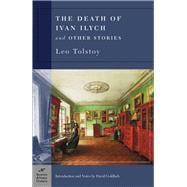What is included with this book?The New copy of this book will include any supplemental materials advertised. Please check the title of the book to determine if it should include any access cards, study guides, lab manuals, CDs, etc.
The Used, Rental and eBook copies of this book are not guaranteed to include any supplemental materials. Typically, only the book itself is included. This is true even if the title states it includes any access cards, study guides, lab manuals, CDs, etc.
From David Goldfarb's Introduction to The Death of Ivan Ilych and Other Stories
The continued popularity of Leo Tolstoy's story "The Death of Ivan Ilych" perhaps owes as much to the author's ability to sympathize with the bad choices his eponymous hero makes as to the fact that this protagonist represents a class still in existence to this day—an upwardly mobile middle class whose members will attend the university and read stories by Tolstoy and will recognize Ivan Ilych as a character they have met, perhaps in their own circle of acquaintances, in their family, or even within themselves. Tolstoy's success in conveying the psychological reality of his characters is not exclusive to his portrayal of Ivan Ilych. It is not uncommon to hear male readers say that they feel they know Anna Karenina as well as they know their own wives, or for contemporary female readers to say that they sympathize with Anna and identify with her in some ways. Though many readers would ascribe genius to Tolstoy, this acuity of psychological perception did not develop without practice.
The forms of the short story, novella, letter, and diary, which offered Tolstoy the possibility for greater narrative experimentation than did long works like Anna Karenina or War and Peace, provided a field for this practice. Written throughout his life, the stories offer some insight into the development of Tolstoy's ideas over time, while the long works, though broad in scope, provide only two snapshots of Tolstoy's evolution as a thinker and writer of fiction. The nineteenth century was generally a very dynamic period in the development of Russian prose forms, as writers reacted to the neoclassicism of the late eighteenth century and attempted to create a prose style that was modern and European but still distinctively Russian and not simply derivative. In an age dominated by realism, experimentation was not merely about style, but about truth in the representation of reality and in the critique of social reality. Where direct political criticism was stifled by tsarist censorship, literature and literary criticism often took its place. For Tolstoy it might be said that this critique is manifested in both the content and in the practice of writing fiction and in his ever-present question "How to live?" The process of writing for Tolstoy provides a means of understanding the subjective feeling of the reality of another person's existence and conveying that feeling to readers, thus creating a bond between the character and readers through the words of the author. Tolstoy's practice of psychological observation and the practice of fiction constitute a spiritual and social practice of forging unity among individuals.
The axis of the most pervasive disunity among individuals in nineteenth-century Russia and beyond is that of gender. Of Tolstoy's stories, the early "Family Happiness" and the late "The Kreutzer Sonata," provide distinct perspectives from which to evaluate Tolstoy's views on "the woman question." "Family Happiness" appeared in 1859, only four years before Nikolai Chernyshevsky's Fourierist novel, What Is to Be Done? This radical, utopian novel proposed the abolition of marriage and the establishment of communes, envisioned a future in which happiness would be guaranteed by technology, and regarded material comfort as the basis for human motivation. By this time Russian women pursued education and had even begun to enter medical school, first by traveling abroad and eventually in Russia itself. Science introduced new methods of contraception and abortion and new views on human sexuality that did not always coincide with traditional religious teachings.
In order to best understand modern life as a woman might experience it, in "Family Happiness" Tolstoy takes the bold step of attempting a first-person narrative in a woman's voice—the story is his only work in this form. As the family was then still the main sphere of women's activity, the problem of "domestic happiness" (as the title may alternately be translated) provides an avenue to most of the issues associated with the woman question, as well as questions about love, the nature of happiness, and what it means to "live for others," which will recur in all of Tolstoy's work. The prose, which evolved from letters between Tolstoy and his friend Valeriya Vladimirovna Arseneva, resembles that of a letter written from the perspective of a woman who has been married and had her first child—written perhaps to a younger woman of the age that the narrator is at the beginning of the story. The letters to Arseneva, which contain a fictional account of a romance between two invented characters, gave the author an opportunity not only to debate important social questions, but to test his ear, to write in a woman's voice that a woman would find believable. The choice of a quasi-epistolary voice is significant in that the sentimental romances that Tolstoy frequently criticizes were often written in the epistolary form or as a narrative in which letters played a significant role. The challenge for Tolstoy here is to write a kind of epistle that is believable and neither sentimental nor a parody of the sentimental epistolary novel in the manner of Dostoevsky's Poor Folk.
Excerpted from The Death of Ivan Ilych and Other Stories by Leo Tolstoy
All rights reserved by the original copyright owners. Excerpts are provided for display purposes only and may not be reproduced, reprinted or distributed without the written permission of the publisher.
